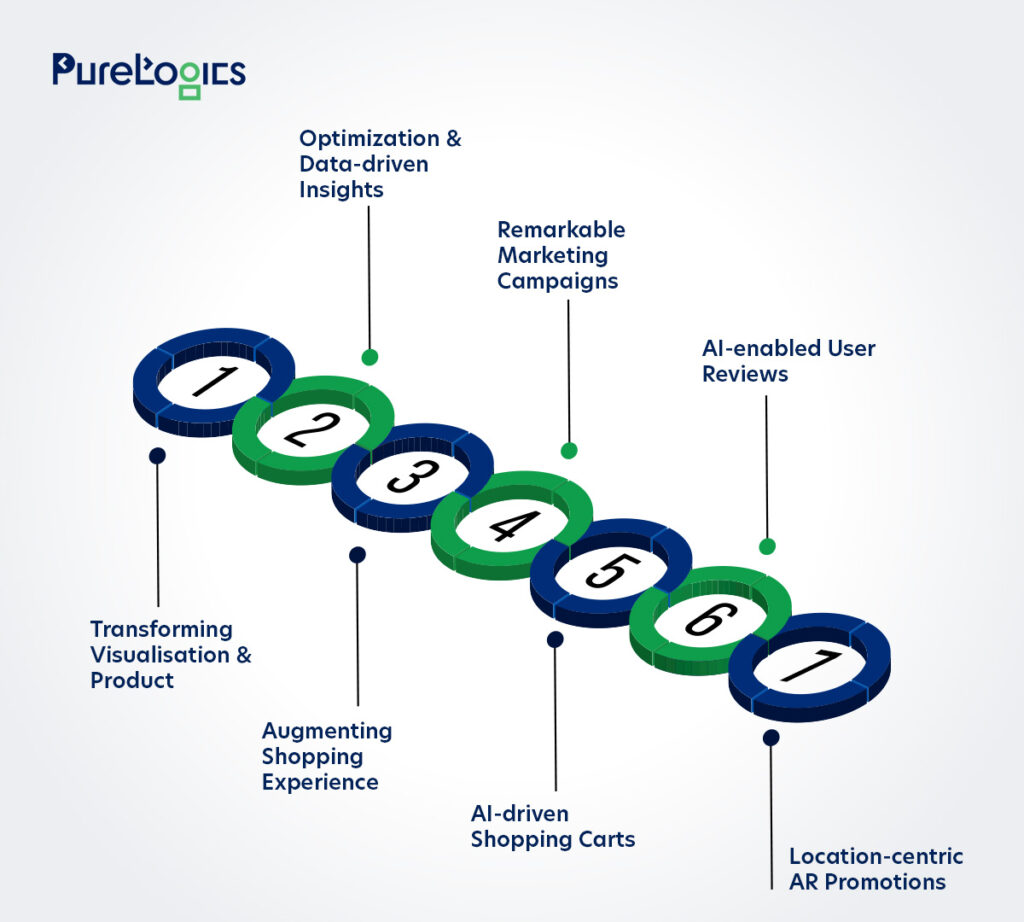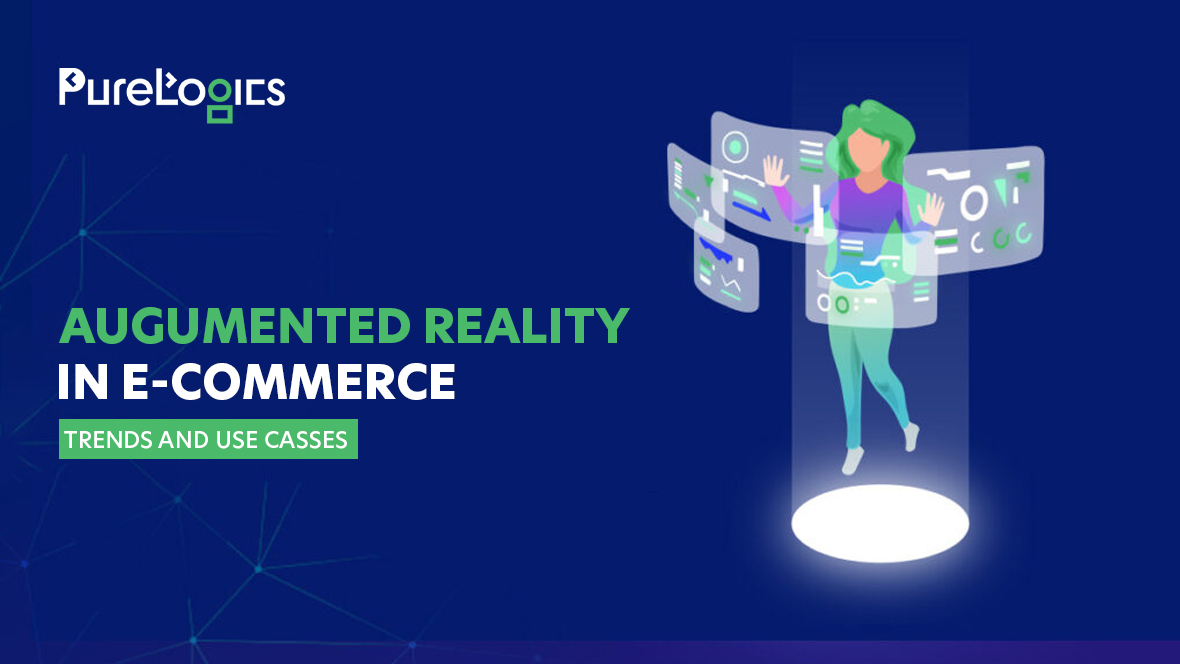The eCommerce industry faces a significant challenge in enhancing customer experiences. Augmented Reality (AR) in eCommerce allows customers to see products in their own space, interact with 3D objects, and gain a deeper understanding of product features to meet their needs, ultimately enhancing satisfaction.
With the rise of new web-enabled AR technologies, businesses focus on personalized shopping experiences and use data analysis to offer customized product recommendations, strengthening connections between customers and companies.
AR in eCommerce also includes tools that cater to individuals with disabilities, providing auditory and visual aids for product instructions.
According to a Statista report, 1.73 billion mobile users will use augmented reality by 2024.
Integrating AR into eCommerce is a transformative leap. It introduces innovative solutions that redefine customer satisfaction and streamline the shopping experience with unprecedented success. This is not just a trend but a revolution that promises to reshape the future of e-commerce.
Augmented Reality vs Virtual Reality in eCommerce
While both technologies offer immersive experiences and are often confused, they have distinct differences. AR tools enhance the real world by overlaying digital information onto it.
AR applications are versatile, working well on tablets, smartphones, and other devices. In contrast, VR headsets immerse users in a virtual world that feels physically real but entirely separate from their surroundings. VR creates fully immersive simulated environments, while AR enhances the real world by integrating digital elements.
Enhancing eCommerce with AR Technology
AR has completely transformed eCommerce, bridging the gap between online and offline shopping experiences. It not only reduces post-purchase dissatisfaction but also fosters customer loyalty. This empowering technology puts the control back in the hands of the customer, enhancing their confidence in their purchase decisions.

Transforming Visualization & Product
AR is crucial in revolutionizing how customers perceive and interact with products. In eCommerce, augmented reality allows customers to visualize products using AR devices and smartphones in real-world environments.
This immersive experience reduces uncertainty, enabling customers to interact with and evaluate products before purchasing. Augmented reality in eCommerce offers benefits such as virtual try-ons for clothing, interactive product information, and customizable options, elevating the shopping experience to new heights. Businesses benefit from AR by enhancing brand perception, reducing return rates, and achieving higher customer engagement and satisfaction.
Optimization & Data-driven Insights
eCommerce businesses are rich sources of customer data. Integrating AR elements into these platforms uncovers valuable insights into customer behavior and preferences. By tracking user interactions, businesses gather data that informs product display optimizations, tailored marketing strategies, and enhanced user experiences.
AR analytics empower eCommerce businesses to optimize product offerings, refine consumer targeting strategies, and stay competitive in the ever-evolving digital market. The synergy between data-driven insights and augmented reality in eCommerce enhances operational efficiency and supports strategic decision-making processes.
Augmenting Shopping Experience
In eCommerce, augmented reality (AR) revolutionizes shopping experiences beyond traditional limits. With AR, customers can virtually try on shoes at home before purchasing, enhancing decision-making through immersive technology.
AR empowers customers to visualize products in their spaces, fostering trust and minimizing purchase uncertainties. Brands can leverage AR app development to offer virtual try-ons, product visualization, and interactive displays, driving higher engagement and sales.
Remarkable Marketing Campaigns
AR enhances eCommerce marketing campaigns with immersive experiences that captivate audiences. Brands can integrate AR to create visually compelling advertisements that attract attention and elevate brand reputation.
Animated product demonstrations allow customers to preview product effects before purchasing, positioning brands effectively in the competitive eCommerce marketplace.
AI-driven Shopping Carts
The AR segment was valued at approximately $5.83 billion and is projected to reach $12.76 billion by 2030. AR-enabled shopping carts revolutionize online shopping by enabling users to visualize products in real-world settings.
This interactive approach enhances decision-making, reduces buyer’s remorse, and boosts customer satisfaction, increasing conversion rates and loyalty.
AI-enabled User Reviews
AR-powered customer feedback enhances transparency and authenticity in eCommerce. Potential buyers can review products through shared customer experiences, making informed decisions based on realistic outcomes.
This fosters trust and loyalty by enabling customers to assess product benefits before purchasing, ensuring a confident shopping experience.
Location-centric AR Promotions
AR in eCommerce facilitates location-based promotions, delivering customized advertisements based on geographical data. This integration enhances user engagement by making marketing campaigns contextually relevant and impactful.
From exclusive offers to personalized discounts, location-based AR promotions cater to specific buyer needs across different locations, effectively driving sales and enhancing customer engagement.
Unlock the Power of AI and AR in eCommerce
Enhance customer experiences and optimize operations with our advanced AI-driven solutions.
AR Technology: Applications and Use Cases
There are various types of AR applications, each designed to enhance user experiences and integrate digital elements into the physical world, boosting interaction:
Superimposition-based AR
Superimposition-based AR in eCommerce involves overlaying computer-generated images (CGI) onto a real-world view in real time. This strategy relies on recognizing and tracking specific objects in the physical environment to augment them digitally.
Location-based AR
Location-based AR, or geospatial AR, uses accelerometers, compasses, and GPS data to analyze users’ positions and orientations. It triggers AR experiences based on the user’s physical location, enhancing contextual relevance.
Projection-based AR
Projection-based AR technology projects digital content directly onto physical surfaces in real time. Businesses utilize interactive surfaces, dynamic overlays, gesture recognition, and spatial awareness to create engaging user interactions.
Markerless AR
Markerless AR operates without requiring markers to initiate AR experiences. It uses software algorithms and cameras, employing computer vision to dynamically track and interact with the user’s environment.
Marker-based AR
Marker-based AR quickly detects specific objects using markers like QR codes, images, or patterns. These markers serve as reference points for the AR application to overlay digital content, providing information and enhancing user engagement effectively.
Overcoming eCommerce AR Integration Challenges
As an innovative company, PureLogics understands the unique challenges of integrating AR into eCommerce. Our approach involves strategic problem-solving and proactive issue recognition, prioritizing seamless UI/UX design to enhance user engagement.
Data analytics is crucial in optimizing AR content delivery and ensuring personalized, data-driven experiences. We leverage cloud-based platforms for scalability and resolve compatibility issues with web-based AR solutions.
At PureLogics, we provide comprehensive user education and robust customer support, simplifying the integration process for enterprises to leverage AR’s potential in eCommerce.
Enhance Your AR Initiatives with PureLogics’ Expertise
In today’s digital marketplace, businesses focus on creative ways to attract and retain customer attention. AR in eCommerce offers innovative methods and flexibility, enhancing user experiences through improved processing power, network capabilities, and device miniaturization.
Developing a quality AR app requires a holistic approach. Our mobile app development services prioritize intuitive interfaces, cutting-edge technology, and rigorous testing, enabling customers to visualize products in their environment seamlessly.
Our integrated digital solutions streamline processes and elevate user experiences, driving higher conversion rates and fostering customer loyalty.
Connect with us to ensure your AR project achieves its full potential and meets every objective effectively.


 [tta_listen_btn]
[tta_listen_btn]
 October 23 2024
October 23 2024






